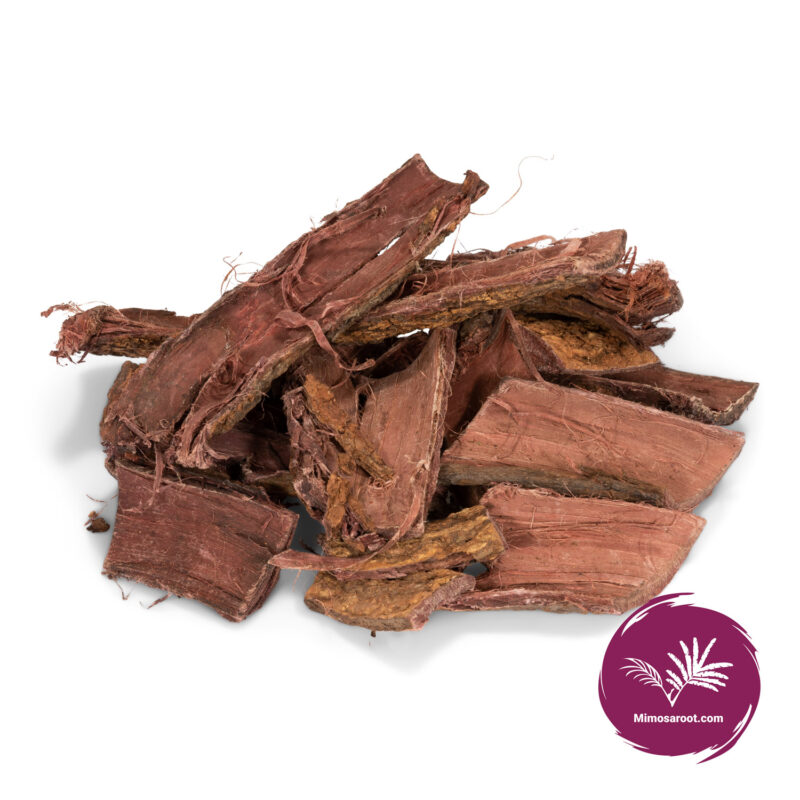Mimosa Hostilis: Ride to the Other Side with Counterculture’s Wildest Root Bark
Mimosa is more than the name for a great cocktail. The giant 8 meter tall mimosa hostilis plant is packed with potent plant compounds. It’s been used for millennia to make soap, clothing dye and DMT. You probably already guessed it’s used in spiritual and shamanic ceremonies.
Dimethyltryptamine (DMT), known in counterculture and plant medicine as the spirit molecule, is one of the most powerful psychedelics on the planet. You also find this potent compound in the Amazonian Ayahuasca brew, and, as you might know, in the human body.
Shamans prepare a psychoactive drink known as “Jurema” (in Brazil), using it to connect with the enchanted realms, seek guidance, and perform healing work on the sick. In many cultures, the plant holds deep cultural significance. It’s also a plant used for healing, for skin care and for wound treatment, and it’s an essential ingredient in many plant medicine systems.
Recently, we’ve seen Mimosa Hostilis become virally popular, both among psychonauts and craftspeople. There has also been a huge surge in interest in natural remedies made from its root bark.
One group grateful for its rise are the passionate folks behind the Mimosa Hostilis Shop, who have been helping to drive this growth. They specialize only in high-quality organic Mimosa Hostilis Root Bark (MHRB) and promote regenerative cultivation, where for every 10 kg of bark sold, they plant another seedling.
After speaking at length with their Mimosa Hostilis expert, Charlotte Drake, we uncovered the story behind MHRB’s rise in popularity over thousands of years.
Mimosa Hostilis Root Bark (MHRB) has a history as rich as the lands it comes from – Mexico, Guatemala, Honduras, El Salvador, Nicaragua, Panama, Colombia, Venezuela and Brazil.
The Origin Story: Secret Jurema Rituals Powered By Mimosa Hostilis
In northeastern Brazil, far from the cocktails on Copacabana beach, Jurema rituals have been practiced for generations upon generations. These ceremonies blend healing practices with profound spiritual exploration.
In Jurema ceremonies, the blessing of foods offered to deities ensures the well-being of the community, while initiation rites grant practitioners access to mystical realms known as the “cities” of Jurema.
Within these sacred spaces, they build relationships with deities and acquire the knowledge necessary to perform healing work and prevent misfortunes. Guided by experienced shamans, these rites use the psychoactive properties of mimosa hostilis to bridge the physical and spiritual worlds.
The Sacred Brew of Jurema
Mimosa Hostilis is also known as mimosa tenuiflora, jurema preta, calumbi, tepezcohuite, carbonal, cabrera and many other localized names. The brew is made from the plant by macerating it in water. It’s actually very similar to Ayahuasca, both in terms of the rituals around it, its chemical composition, and its effects.
The roots are carefully crushed against each other to effectively remove all dirt and the outer bark, ensuring that only the valuable inner root is preserved for the brewing process. This inner root is then placed into a plastic container filled with cold water.
Here, it undergoes a process of being repeatedly squeezed, which continues until the water transforms into a rich, deep reddish-brown hue. During this process, a layer of foam may form on the surface; this foam, along with any coarse residue that may be present, is carefully discarded. This meticulous procedure ensures that only the pure liquid extract remains.
The key to the brew is of course DMT but the plant contains many other alkaloids, all contributing to the psychoactive experience.
Mimosa Hostilis Soap and Dye Making
In the modern world, Mimosa Hostilis is still used for dyeing clothes and making soap. From tie dye t-shirts in the classic hippie style to luxury soaps made with organic ingredients MHRB is an increasingly popular ingredient thanks to its rich tannins.
What is Mimosa Hostilis Root Bark Powder Used For?
MHRB powder has been used for centuries in traditional medicine and forms a key ingredient in psychoactive drinks used during spiritual practices, particularly in South America. Today, it’s also valued for its tanning and dying properties and as an antimicrobial and antiseptic agent for soap and other skincare products.
What is MHRB Powder?
MHRB powder is the ground form of Mimosa Hostilis Root Bark. It’s often sold as shredded or powdered, or a blend of the two, and comes from Brazil or Mexico. Mimosa Hostilis Shop offers free shipping across the US, all at wholesale prices.
What are Mimosa Tenuiflora, Mimosa Pudica, and Tepezcohuite?
Mimosa Tenuiflora, commonly known as Mimosa Hostilis or Tepezcohuite, is a perennial tree or shrub native to the northeastern region of Brazil and parts of Mexico. The term Tepezcohuite is mainly used in Mexico.
Mimosa Pudica is a related, but different species of plant known for its sensitive leaves that fold inward when touched. It is not the same as Mimosa Tenuiflora and does not have the same health and wellness uses. Mimosa Pudica does not contain DMT.
Does Mimosa Hostilis Contain DMT?
Yes, Mimosa Hostilis contains DMT (Dimethyltryptamine), a compound used in various traditional spiritual ceremonies to induce transformative, profound psychedelic experiences. The dried root bark of Mimosa Hostilis can contain between 1.0% and 2.5% DMT, making it a significant source of this compound.
In recent years, DMT has attracted scientific interest due to its potential therapeutic effects, such as anxiolytic and antidepressant properties, which are being explored in clinical trials for mental health therapies.
What Are Extracts? And How to Extract from MHRB?
Extracts are concentrated forms of active compounds derived from plants, used for various applications such as herbal remedies, cosmetics, and research. Extracting compounds from Mimosa Hostilis Root Bark (MHRB) involves using solvents to isolate the desired components.
This process should be approached with caution, adhering to all legal and ethical guidelines, as regulations regarding plant extracts can vary by region.
Where to Buy Mimosa Hostilis Root Bark?
MHRB powder can be purchased online, labeled as dye-making or soap making supplies. To ensure the quality and authenticity of the product, it’s important to buy from reputable suppliers, such as Mimosa Hostilis Shop.
Look for sustainable suppliers, careful harvesting processes and good quality control. The key is buying consistent, good quality, organic mimosa bark or powder that has been produced professionally.
Is Mimosa Hostilis Legal in the US?
Mimosa Hostilis, also known as Mimosa Tenuiflora, is legal to possess in the United States. However, it is important to note that while the plant itself is not controlled, the extraction and possession of DMT, a compound found in the root bark of Mimosa Hostilis, is illegal under federal law, as DMT is classified as a Schedule I controlled substance.
This means that while you can legally purchase and possess Mimosa Hostilis, using it to extract DMT would be illegal.
How to Dye Clothes with Mimosa Hostilis?
Dyeing clothes with MHRB creates deep, earthy natural color tones. Boil the bark in water to extract the natural tannins, and then drop your fabrics into this dye solution.
How to Make Soap with MHRB?
MHRB is known for its skin-soothing properties, making it a popular ingredient in high end homemade soaps. Mix the powdered bark with a soap base and add essential oils for a natural, nourishing soap.






